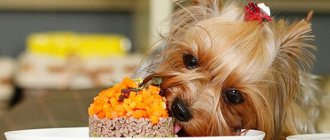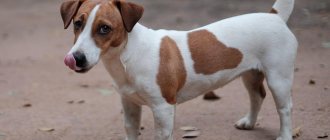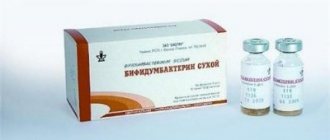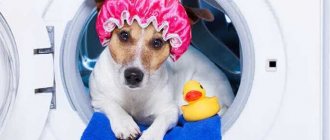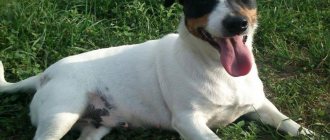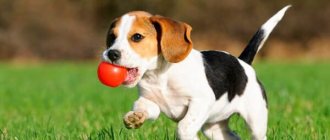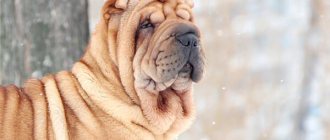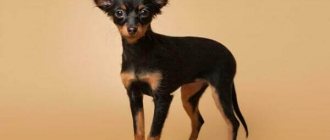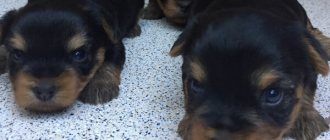The Jack Russell Terrier is originally a hunting dog breed.
She is distinguished by her instant response, activity and friendliness.
Nowadays, this dog has become an excellent companion for people who do not sit still and lead an active lifestyle.
In this article we will talk about Jack Russell puppies - how to choose them and how to care for them. We will also show you photos of these cute babies.
Brief information about the breed
Dogs of this breed were bred in Great Britain for burrowing . The breed combines small size, strength, courage and powerful jaws. All this was needed to penetrate the hole and grab prey.
NOTE!
The breed is named after the English pastor John Russell from Devonshire. He was very fond of horse hunting, and it was he who first described these dogs.
Nowadays, the Jack Russell Terrier has an average weight of 5-7 kg, and a height at the withers of 25-31 cm. The skull is slightly narrowed towards the eyes. The eyes themselves are shaped like almonds, dark and deep-set. The chest has a girth of 40-43 cm, the tail is docked. The life expectancy of dogs of this breed with proper care is on average up to 14-15 years.
From the first days, Jack Russell Terrier puppies are characterized by excessive activity and a desire to dominate their owner, therefore, in order to turn a Russell into a well-mannered dog, you will have to make a lot of effort. Raising a Jack Russell should take place without shouting and beating, but at the same time without indulging in all the dog’s pranks, which will turn the puppy into a real little devil in the future.
To prevent bad behavior, you need to stop any antics of your pet, not be touched by his pranks, and not allow the dog to become the main one in the house and manipulate you.
What to buy for a Jack Russell Terrier puppy
Before purchasing a puppy, you need to buy a few essential things for him . The baby will need:
- Two bowls, preferably on a stand. The naughty boy will turn over floor bowls while playing with water.
- A soft rug, bed or foam house.
- Small soft collar and roulette leash. It is better to immediately take a leash based on the weight of an adult jack. The harness is purchased only after trying it on.
- Soft and rubber toys, squeakers and balls, a whole beef bone. The sinew bones are too hard for a small puppy, so he won't play with it.
- A large crate designed for an adult dog.
- If you adopt a puppy during the cold season, then you need to buy or make a warm blouse or overalls for him.
The list of things a dog needs will eventually be replenished with hypoallergenic shampoo, a rubber brush, vitamins, new toys and new things. Your puppy will need tick repellents, various treats, and a brush to help care for his teeth.
What do newborn puppies look like?
Puppies are born blind, their muzzle and body do not yet have the proportions of an adult dog, so it is not yet possible to judge their future appearance. This can be done much later.
The puppy's coat already has a color that will remain in the future. The tail is pressed to the body, the ears puff up. The tip of the nose and paws are pink or pinkish in color. The type of coat is not yet clear.
Jack Russell puppies are 14-16 cm in size at birth. Weight usually exceeds 200 g and ranges from 200 to 250 g.
These indicators are not universal, they depend on:
- heredity;
- the period at which the puppies were born;
- number of puppies in the litter.
Water
A bowl of clean water should always be within reach of the puppy. Particular attention is paid to water if:
- the dog is fed ready-made pelleted food;
- has high physical activity.
The body's water balance is an important indicator of health. If you consume too little water, as well as if you consume too much, you should seek the help of a specialist.
Development by months
At one month the puppy already has its first teeth:
- fangs;
- incisors;
- the first and second false-root ones.
He begins to emerge from his den along with the other puppies.
This is the time when you need to start toilet training your dog. During the first month, the breeder observes an increase in the puppy’s activity and how he gets used to his name. The dog develops a daily rhythm.
IMPORTANT!
At the age of 45 days it is recommended to brand the puppy. At this time, the baby is also already accustomed to hygiene procedures - combing, cleaning the ears and examining the teeth.
The puppy continues to explore the world. Closer to the age of two months, he begins to better remember commands, chew and ruffle objects around him. He is growing and gaining weight, but at this age it is still impossible to see the puppy’s shortcomings.
Further development occurs in the following order:
- At 2-2.5 months, the puppy begins a period of fear. At this time, you need to communicate with him as much as possible and avoid things that would frighten the dog. Also at this time the puppy is already switching to food. At 2 months, the puppy begins to bark and all of his baby teeth appear. This is the right time to start accustoming him to trips and walks. The dog continues to grow and gain weight;
- from 2 to 5 months, the proportions of the dog’s head and body are determined. Character and teeth change;
- at 3 months the dog is already ready for independent life. During these three months, his individual character traits are formed;
- from 4-8 months the dog begins to want to run away from its owner. This is the time for the dog's "sexy" games. The optimal age to move to a new family. The puppy is fully formed and after changing teeth the bite is visible. At this age, the dog’s character, its preferences and habits are visible;
- at 7-8 months the dog’s growth stops;
- at 8-9 months the dog’s teeth finally change. Fangs that have not fallen out need to be pulled out;
- from 6-10 months the bitch begins her first heat and puberty begins. Males mark their territory and raise their paw;
- 6-12 months is a time of fear of new situations. A new trusting relationship is formed between the dog and the owner. During this period, you should not force the dog to approach the object that it is afraid of;
- at 12 months, the dog completes the formation of the “dominance-submission” relationship.
Final teams (6-8 months)
When the baby is six months old, it’s time to teach him how to behave in crowds and on public transport. At the same time, already learned commands are reinforced. So, the final set of commands and the learning process for them looks like this:
Table 3. Training the Jack Russell Terrier to commands at the age of 6-8 months
| Team | How to teach? |
| Jumping over barriers | Pick up a stick, branch or pull a rope. Stand on the other side, show your pet a treat and beckon it to you. When the pet jumps or steps over, give a “yummy”. Gradually the height of the barrier needs to be increased |
| Moving in crowded places | Walk your dog on busy streets more often, starting with the least crowded places. Gradually, the pet will no longer be afraid of crowds of people and cars passing by. |
| Riding on public transport | It happens gradually. First, the pet is allowed to get used to the stops by walking nearby and gradually approaching. Then it is recommended to choose a time when there will be fewer people on the bus/tram and go there with your pet. The first time it is better to carry it in your hands. After the second and third trip, the pet will get used to the transport |
| Following the trail, the command “Search!” | Take the owner’s thing, let the dog smell it, then hide it and command “Search!” If she finds the wrong thing, say “Ugh” and repeat the command. Praise after the dog finds the desired item |
Active games continue, during which the commands “voice”, “walk”, “crawl”, “next” and others are trained. New teams are gradually being added to them. In addition, a six-month-old puppy should already be able to find its owner by smell. However, you should not endlessly train your pet; you should take breaks between classes. The baby's growing body is not yet strong enough for such stress.
At the same time, already learned commands are reinforced
Important! At this age, it is necessary to instill in your pet distrust of strangers. He must refuse food given to her by a stranger.
Accustoming to accessories
Most Jack Russell Terrier owners stop at teaching their puppies simple commands and instilling obedience in them. However, animals that are being prepared for exhibitions or frequent travel require additional training: developing the habit of sitting in a cage and getting used to a muzzle.
Dog in a muzzle
The latter is instilled in the animal during puppyhood. The process occurs gradually according to the following algorithm:
- a muzzle is given to the baby so that he can sniff an unfamiliar object and make sure it is safe;
- a favorite treat is placed inside the muzzle so that the terrier, reaching for it, completely immerses his muzzle;
- the owner makes sure that the pet does not take food bypassing the muzzle;
- immediately after the terrier reaches for the piece, a second one is placed in the muzzle so that the baby keeps his muzzle in it longer;
- the second piece of treat is added at each training session at a different time interval;
- after 7-8 seconds of the baby being in the muzzle, the clasp is snapped and then immediately unfastened;
- at the next stage of training, a treat is given after putting on the muzzle;
- the final stage - they put a muzzle on the dog and go for a walk, preventing attempts to remove it.
After finishing the walk, the owner removes the muzzle himself while the pet is distracted by playing or something else.
Jack Russell waiting for a walk
Training for exhibitions
To prepare a puppy for exhibitions or some kind of show, he must be taught the commands “near”, “sit”, “show teeth”. In addition, it is very important to instill in the animal the habit of sitting in a cage without worry or fear. This training is carried out according to the following algorithm:
- The cage or carrier is opened and a piece of your favorite treat is placed in it - hard cheese or dry food. The dog is given the opportunity to pick it up.
- The procedure is repeated several times. When the puppy begins to fully enter the crate, he is praised and rewarded with a treat.
- At the next stage, the puppy must enter an empty crate, and the treat is given only after he is completely there and spends a few seconds.
- The owner must not interfere with the pet leaving the carriage. The dog can go out whenever he wants.
- When the pet comes inside the cage, stops and freezes, he is praised and rewarded with treats the entire time he is there.
- Then the owner gives the command “Lie down!”, after which he praises the pet and gives a treat.
- When the dog begins to feel confident in the crate, the door is closed and immediately opened. The pet is given a treat.
- With each training session, the time the animal spends inside the cage with the door closed increases. But at any sign of uncertainty, the “jack” is allowed to come out.
Jack Russell Terrier in a cage for transportation
Accustoming to transportation should be carried out in a measured and comfortable environment for the baby, despite the fact that the process can last from 3 to 5 days. It is very important to choose the right carrier or cage. The height of the cage is calculated according to the formula: pet’s height + 10-15 cm, and the body of the “jack” along with the owner’s hand should fit into the open door without any problems.
Raising a show dog
Training for hunting
The Jack Russell Terrier breed was originally intended to be a hunting dog, so some owners buy a terrier specifically for this purpose. In order for a pet to become a good hunter, it is necessary to initially accustom it to the sounds of gunshots so that the assistant does not get scared and run away in the most critical situation.
A wonderful representative of burrowing hunting dogs
Training occurs according to the following scenario:
- It is necessary to find an accomplice who will be assigned to shoot the scarecrow. Initially it is located about 150 meters from the dog walking area.
- The owner goes for a walk with the dog, starts playing with it, talking affectionately and praising it for following simple commands. At some point, the owner gives a sign to his assistant, unnoticed by the dog, and he shoots.
- After the shot, the pet should become alert and turn towards the unfamiliar sound. The owner continues to play with the dog as if nothing had happened.
- After a few minutes, the distance to the assistant with the weapon gradually decreases, and the shot is heard again. At this time, you need to look at the pet’s reaction: if the dog gets scared, starts to break from the leash and tries to run away, you cannot scold it. On the contrary, you need to pet him, calm him down and go home.
- The training is repeated after 3-4 days. The dog will be ready for such sharp sounds and will behave calmer.
After a few lessons, you will be able to achieve the usual reaction of a hunting dog: when fired, it will turn in the direction of the sound, prick up its ears, and at any moment, on the orders of its owner, will rush in pursuit.
Grown-up Jack Russell Terrier on the hunt
Types of puppies
In newborn puppies, it is not yet clear what type of coat the puppy will be. This can only be understood when the puppy reaches 3 months.
One way or another, Jack Russell Terrier dogs are divided into three types based on coat type:
- smooth-haired – the coat is close to the body, the undercoat is dense;
- long-haired or wire-haired – hard and long hair that does not adhere to the dog’s body;
- intermediate or brocken - the dog does not grow eyebrows or a beard, the length of the coat is longer than that of other types, but it is adjacent to the body, and does not bristle, like long-haired dogs.
Why is it recommended to weigh puppies at birth?
The main task of babies in the first days of life is to sleep and eat in order to gain weight and get stronger. Puppies are born with an innate sucking reflex and usually attach themselves perfectly to the bitch on their own. But in some exceptional cases, more agile and stronger siblings can push the weaker one away from the nipples. If you do not pay attention to this in a timely manner, in a few days such a baby will become completely weak, and he will not have the strength left to suck milk from the bitch’s breast on his own. Toga's owners will have to intervene and feed this puppy every two hours from a syringe with expressed milk or a bitch's milk replacer until he can suckle productively on his own. For the first feedings, 0.5-1 ml of milk is enough.
Regular weighing of puppies will allow owners to monitor the weight of each puppy and control the size of the increase. Ideally, weight gain should be daily!
For example, I’ll say that in 5 days of life, our puppies gained from 45 to 140 grams each. If at birth they weighed more than 200 grams, then after 5 days the weight of each of them exceeded 300 grams.
Source
Features of care
Before the puppy comes into your home, prepare the space - remove small objects and wires, as well as other things that could harm the baby, from visible places. Remove personal and expensive items that could be damaged.
Prepare a place for the puppy. There should be no drafts, windows, or heating objects near it. Try to make it a place where the dog is at peace. If you need to isolate your baby for a while, use a playpen, cage or enclosure.
As soon as the puppy appears in the house, show him who is the boss. Designate an area where he can play, sleep, eat, and where he should stay away. It is better not to retreat from such tactics. Raise your puppy from the first days, while he is still trainable.
There should always be toys in the Jack Russell's personal place that will distract him while you are busy with your business or while you are relaxing.
Train him to toilet in a timely manner - usually after sleep or after eating. Buy a special diaper at a pet store. As soon as you notice the puppy’s anxiety, show him a place to relieve himself.
After the required vaccinations, you can accustom the puppy to the street. To do this, use an already used diaper - the dog will react to the smell.
The first walks should be no more than 10 minutes. As the puppy grows, increase the time. Even if the weather is bad outside, be sure to take the puppy out, at least so that he can go to the toilet.
Don't forget to play active games with your puppy during walks. Stop your puppy from chasing other dogs and cats. Teach him discipline.
Brush your puppy several times a week. During molting season - daily. Puppies with long hair will have to be taken to a grooming salon. Teach your baby to behave calmly during hygiene procedures.
NOTE!
Don't forget to clean your puppy's ears and trim his nails. If necessary, rub your eyes. To care for your teeth, purchase a special brush from a pet store.
You can bathe the puppy after scheduled vaccinations, when two weeks have passed. This breed does not need to be washed frequently, but only with special shampoos. On average, Russells are bathed three times a year.
Read about other features of Jack Russell care here.
Care and maintenance of Jack Russell puppies
Features of care
Jack Russell puppies are strong and healthy; babies of this breed do not need labor-intensive and expensive grooming, but the owner must carry out the following procedures regularly:
- Eye care . Wipe your eyes in the morning using a dry cotton pad or a regular paper napkin. A healthy puppy has almost no discharge from the eyes, so he does not need to use special solutions.
- Ear care . The ears are wiped once a week, cleaning the shell with a cotton pad soaked in a solution of Chlorhexidine.
- Grooming . _ The coat of a smooth-haired baby is combed with a special brush, which not only removes loose hairs, but also gently massages the skin.
- Paw care . Your pet's nails wear down naturally when he walks a lot on hard surfaces. Walking on gravel or asphalt helps strengthen the ligaments and wears down the claws. But if the claws grow so long that they interfere with the puppy’s walking, he begins to lame and the posture of his limbs is formed incorrectly. The claws are trimmed with a special guillotine, trying not to touch the nerve and blood vessel located just above the edge.
Content Features
The Jack Russell puppy is stubborn and able to make decisions on his own, has a wild temperament and requires as much attention as possible . Dogs of this breed cannot live in an enclosure or on the street, are not able to sit on a chain and love comfort. Apartment housing implies early training in neatness, and the puppy must be trained to use the toilet outside, without waiting for the end of the vaccination quarantine. Otherwise, the stubborn terrier will make puddles indoors for a very long time, and it will be difficult to wean him from this habit.
Walking and playing are little Jack's favorite activities . A puppy of this breed has enough energy to pester family members for many hours with a toy in his mouth, to strive to track down and catch up with the neighbor's cat and to eat any garbage. The kid will dig huge holes in the flower beds, tear at the bushes and try to tear the canopy over the swing in the garden, and also start quarrels with his fellow tribesmen on the playground.
The owners of a puppy of this breed can only dream of peace, since the pet requires almost round-the-clock attention . To prevent damage to things, as well as for the safety of the puppy itself, you need a crate where the baby will spend time in the absence of the owners. By locking a pet in it, owners can be sure that the fidget will not chew electrical wires or damage the upholstery of upholstered furniture.
Important! A crate for a Jack Russell puppy is a cozy home with a rug and toys, not a prison.
When walking, it is better not to let a puppy of this breed off the leash, as he may get carried away chasing a bird or a cat or get hit by a car. A roulette leash is perfect for walking, the length of which is automatically adjusted.
What should the diet be like?
In the first few weeks that you have a puppy, you should feed it the same as the breeder fed it, gradually transitioning it to the desired diet .
If you plan to feed your Jack Russell with industrial food in the future, then choose premium or super-premium products.
If you want to feed your pet natural food, then begin to gradually introduce the following products into his diet:
- meat;
- fish;
- dairy products;
- cereals;
- vegetables and fruits;
- eggs.
For 1 kg of puppy, 20-30 g of meat per day is required.
Ideal meat choices include beef, turkey and chicken breast. Shred the beef before serving, but you will have to cook the chicken and turkey.
A couple of times a week you should give fish, but only sea or ocean fish. Before serving, boil and remove bones.
At first, small puppies should replace cow's milk with 10% cream diluted with water. Calcined cottage cheese can also be an alternative. It should be given several times a week, 30-50 g.
You can start your first complementary foods with buckwheat and rice porridges.
The Jack Russell digests carrots, beets, zucchini and pumpkin best. During the season, you can add a little greenery to them.
You can give an apple as a fruit. You can give other fruits if the puppy is interested, but you should avoid feeding citrus fruits .
Sometimes give your puppy an egg omelet, but no more than 1-2 times a week.
Prohibited Products
It is important to exclude prohibited foods from your Jack Russell puppy’s diet:
- Bones, pure fat, skin, especially poultry.
- Palm oil.
- Grapes, raisins.
- Soy.
- Mushrooms.
- Corn and semolina.
- Raw freshwater fish.
- Dry, salted fish.
- Products containing sugar or sugar substitutes.
- Products containing xylitol (chewing gum, some sweets).
- Products containing flour or yeast.
- Products containing caffeine, cocoa, any stimulants (sweets, tea, coffee, chocolate).
- Products containing marinades, salt, spices.
- Smoked products, including sausages, balyki, fish.
- Expired products.
- Leftovers from the table.
Controversial products are:
- Lean raw pork.
- Raw ocean fish.
- Whole milk.
- Honey.
- Chicken eggs.
- Raw and boiled chicken liver in large quantities.
Controversial products can and should be given to a Jack Russell puppy if an allergic or other acute reaction does not occur after taking them.
How to feed?
The Jack Russell should eat from a bowl on a special stand that can be adjusted as the puppy grows.
Don't feed him from the table, even if he asks. Accustom your dog to a routine - to eat in a certain place at a certain time.
If you decide to feed your puppy natural food, make sure that he receives all the necessary substances and that the diet is balanced.
CAREFULLY!
Do not give your puppy sweet, pickled, smoked, fatty or salty foods. This will lead to health problems.
Food should be at room temperature.
From 4 months, you need to feed your puppy six times a day, reducing the number of feedings every month. After 9 months, the dog should eat 2 times a day.
Make sure your dog always has fresh water at room temperature.
Ready-made feed
The manufacturer does its best to please the pet and its owner. Ready-made feed:
- varied;
- fragrant;
- comfortable;
- delicious (judging by the appetite of dogs).
In addition, pouring granules from a bag into a bowl, which you then don’t have to wash, is easy and simple. The huge shelf life allows you to purchase a “bag” once and solve all problems.
No matter what kind of advertising ready-made food is used, it is very difficult to look into its essence. Independent laboratory tests have repeatedly confirmed that they do not contain the nutrients, vitamins and minerals stated in the formulation (even the most expensive ones).
Feed, during the production process, is subject to high temperatures, therefore, devoid of biologically active substances and many non-heat-stable vitamins. Such food cannot be balanced.
Advantages
- fast;
- purely;
- simply and easily.
Flaws
- inability to control the composition;
- the presence of artificial ingredients that can cause allergies;
- inconsistency of labeling with laboratory examination indicators.
First vaccinations
At 21 days, the puppy and mother are dewormed. This is usually done with a suspension of Drontal Junior, Pirantel and other drugs.
At 4-6 weeks they are vaccinated against distemper and parvovirus enteritis.
At 3-9 weeks the following vaccinations are given:
- repeatedly from plague and parvovirus enteritis;
- from hepatitis;
- from parainfluenza;
- from leptospirosis.
At 12 weeks, revaccination against distemper, hepatitis, parvovirus enteritis, and leptospirosis is carried out. Vaccination against rabies is carried out.
At 6-8 months after changing teeth, revaccination against distemper, hepatitis, parvovirus enteritis and leptospirosis is carried out.
Vitamins and supplements
Vitamin preparations are medicinal substances. If there are no signs of vitamin deficiency, the puppy is energetic, the quality of the coat and mucous membrane is good, then there is no point in introducing synthetic additives into the diet.
If any pathology occurs, a comprehensive examination is necessary. You cannot use vitamin without a diagnosis - it will delay time and will not give the expected effect.
Price range
How much does a Jack Russell puppy cost?
The highest price for a dog is set when the dog is 5-6 months old. The lowest price is for a puppy one and a half months old.
This is explained by the fact that both its advantages and disadvantages are already visible in a grown-up puppy. If you take a baby, you are literally playing the lottery.
Based on this information, the standard price range for a Jack Russell Terrier puppy ranges from 20 to 40 thousand rubles, taking into account pedigree and vaccinations and provided that you take the puppy from an experienced breeder.
If this information is not important to you, then in this case the price for a Jack Russell starts at 10 thousand rubles.
Important Tips
To properly care and raise a Jack Russell Terrier puppy, you need to learn several important rules:
- You cannot lift the puppy by its paws;
- games with tugging ropes are prohibited - this will ruin the baby’s bite;
- up to ten months, the pet should not go down the stairs on its own; you will have to carry it in your arms, otherwise it may dislocate the joint;
- a Jack Russell Terrier puppy should not jump over high obstacles to avoid fractures;
- do not overdo it with physical activity - do it gradually as your dog develops;
- if the pet is sleeping, then you cannot wake him up - let him rest as much as he wants;
- After eating, do not allow the baby to frolic so as not to disturb digestion;
- Immediately stop your Jack Russell Terrier puppy from biting you, otherwise he will do it constantly;
- if you catch your pet at the scene of a crime, then explain in a serious tone that this cannot be done, but never yell at the puppy;
- if the pet complies with your order, then be sure to praise it in a gentle tone and reward it with a treat;
- Do not leave your Jack Russell Terrier puppy alone for a long time, he is very afraid of loneliness. If you urgently need to go somewhere, put him in the playpen and give him his favorite toys - this will distract the baby for a while;
- never leave your dog in a closed car in the hot season - it may overheat;
Everything you want from your pet must be taught to him in advance. Just like prohibiting in time what should not be done. While the pet is small, it is easy to train, but if this moment is missed, then the cute terrier will turn into an uncontrollable dog.
What advice can you give on the care and education of a Jack Russell Terrier?
How to choose a puppy?
As with many breeds, the Jack Russell has certain standards that you need to familiarize yourself with so as not to be deceived.
You also need to pay attention to the following:
- the puppy should be active and mobile, look cheerful. Avoid shy and indifferent dogs;
- length and height should be proportional. The puppy's structure should be proportional;
- According to the standard, the dog's head should be of medium width and taper towards the eyes and ears. The nose should be black, the eyes should be black almond-shaped, and the jaw should be strong. The ears should be V-shaped and close-fitting;
- check the dog's appearance and proportions. Are there any external defects? The puppy must have an athletic appearance;
- from the rear, even a puppy should look strong and muscular. The tail should be set high. A healthy puppy always wags him happily;
- pay attention to the wool. If the puppy is smooth-haired, check for fine spots. A long-haired puppy or brocken should not look fluffy. 51% or more of the color must be white. Acceptable colors are red, black and brown shades;
- The puppy's gait should be lively and even.
Choosing a place and utensils for feeding the puppy
The puppy eats quickly and a lot, despite its modest size. It should be taken into account that eating for a Jack Russell is a passing activity; the puppy quickly runs up to the bowl, swallows what is in it and switches to a more interesting activity.
What should you pay attention to when choosing a place and utensils for feeding?
- In order to prevent diseases, the puppy's eating area should be clean.
- In order to prevent injury, care must be taken to ensure that the student does not slip when running to the bowl, even if the floor is wet.
Important! When choosing bowls, it is better to give preference to models with low sides. The bowl should be made of ceramic or stainless steel. It is better not to use plastic accessories.
Weaning off causeless biting and aggression
An important role in raising a dog is the eradication of character problems. Be sure to wean the terrier from causeless barking and spontaneous biting. Puppies periodically bite, chew things if they cut another tooth. If the dog bites the owner, you need to take the jaws in your hands and lightly scold him, strictly saying “No.” When eating, the bowl is held in front of the pet's face so that the owner's hands can be seen. A well-mannered dog understands that these hands feed him and that biting them is prohibited.
Terriers cannot stand being alone, so they constantly bark or whine loudly. Before leaving home, be sure to take the animal for a walk so that it can release its energy and fall asleep. To help your dog hear voices, you can leave the radio on. Toys or food are left for entertainment, but if the animal behaves restlessly, then they hire a nanny for it or ask a neighbor to look after it. It is strictly forbidden to allow a dog to jump on a lying owner, since he feels more important than him and stops listening to him. This negatively affects the training process, so allowing such behavior is strictly prohibited, even in a playful way.
